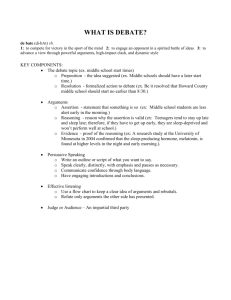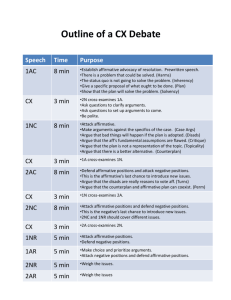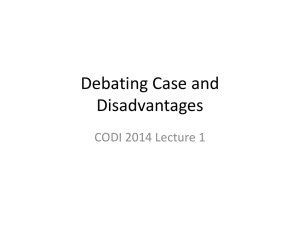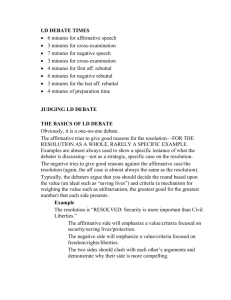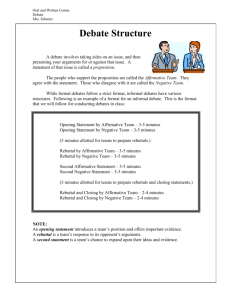Debate Lectures and Glossaries
advertisement
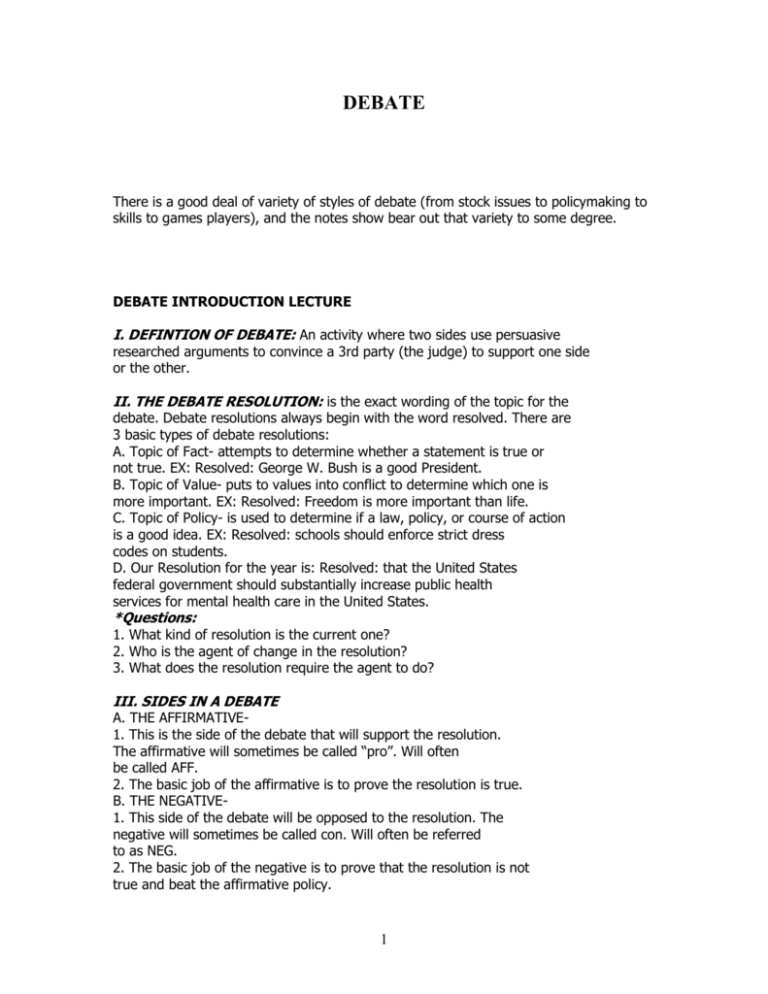
DEBATE There is a good deal of variety of styles of debate (from stock issues to policymaking to skills to games players), and the notes show bear out that variety to some degree. DEBATE INTRODUCTION LECTURE I. DEFINTION OF DEBATE: An activity where two sides use persuasive researched arguments to convince a 3rd party (the judge) to support one side or the other. II. THE DEBATE RESOLUTION: is the exact wording of the topic for the debate. Debate resolutions always begin with the word resolved. There are 3 basic types of debate resolutions: A. Topic of Fact- attempts to determine whether a statement is true or not true. EX: Resolved: George W. Bush is a good President. B. Topic of Value- puts to values into conflict to determine which one is more important. EX: Resolved: Freedom is more important than life. C. Topic of Policy- is used to determine if a law, policy, or course of action is a good idea. EX: Resolved: schools should enforce strict dress codes on students. D. Our Resolution for the year is: Resolved: that the United States federal government should substantially increase public health services for mental health care in the United States. *Questions: 1. What kind of resolution is the current one? 2. Who is the agent of change in the resolution? 3. What does the resolution require the agent to do? III. SIDES IN A DEBATE A. THE AFFIRMATIVE1. This is the side of the debate that will support the resolution. The affirmative will sometimes be called “pro”. Will often be called AFF. 2. The basic job of the affirmative is to prove the resolution is true. B. THE NEGATIVE1. This side of the debate will be opposed to the resolution. The negative will sometimes be called con. Will often be referred to as NEG. 2. The basic job of the negative is to prove that the resolution is not true and beat the affirmative policy. 1 IV. SPEECH TIMES AND ROUND STRUCTURE A. TIMES- there are 4 kinds of time in debate: 1. The CONSTRUCTIVE speech- each speaker in a debate round will get a constructive speech. The constructive speech has the is 8 minutes long, and it is used to present and build new arguments into the debate. 2. The REBUTTAL speech- each speaker in a debate will get a rebuttal speech. The rebuttal is 5 minutes long, and it is used to clarify, rebuild, and summarize arguments. It is important to remember that, in a rebuttal, there should be no new arguments. 3. CROSS-EXAMINATION is the 3 minute time period in a debate where a debater will ask an opponent questions about the arguments. The purpose of cross-ex is to clarify your opponent’s arguments, get any missed arguments, and set up your own arguments. 4. PREP TIME is the time given to each team to prepare for speeches. Each team is given a total of 5 minutes. B. ROUND STRUCTURE1ST AFFIRMATIVE CONSTRUCTIVE (1AC)- 8 MINUTES CROSS EX- 1A X 2N- 3 MINUTES 1ST NEGATIVE CONSTRUCTIVE (1NC)- 8 MINUTES CROSS EX- 1N X 1A- 3 MINUTES 2ND AFFIRMATIVE CONSTRUCTIVE (2AC)- 8 MINUTES CROSS EX- 2A X 1N- 3 MINUTES 2ND NEGATIVE CONSTRUCTIVE (2NC)- 8 MINUTES CROSS EX- 2N X 2A- 3 MINUTES 1ST NEGATIVE REBUTTAL (1NR)- 5 MINUTES 1ST AFFIRMATIVE REBUTTAL (1AR)- 5 MINUTES 2ND NEGATIVE REBUTTAL (2NR)- 5 MINUTES 2ND AFFIRMATIE REBUTTAL (2AR)- 5 MINUTES 2 DEBATE INTRODUCTION LECTURE TERMS DEBATE TOPIC OF FACT TOPIC OF VALUE TOPIC OF POLICY RESOLUTION CURRENT RESOLUTION AFFIRMATIVE NEGATIVE CONSTRUCTIVE REBUTTAL CROSS-EXAMINATION PREP TIME ROUND STRUCTURE 3 BASIC AFF THEORY LECTURE I. THE BASIC JOB OF THE AFFIRMATIVE IS TO PROVE THAT THE RESOLUTION IS TRUE. A. The affirmative will do this through building a policy that solves a problem that falls within the resolution. B. In order to make a policy, the affirmative must identify a problem, isolate the cause, and develop the solution. When the AFF does this, they have met their burden to present a “prima facie” case. C. A prima facie case is one that meets all the affirmative burdens and would convince a normal judge on first look at the case. II. THE PROBLEM: SIGNIFICANCE AND HARM A. Significance is the quantitative measure of the problem that Aff identifies. 1. Significance is often the numerical measurement of the problem, i.e. how many people, nations, forests, etc. are affected. 2. Think of significance in terms of “how big” the problem is…or the “size of the problem B. Harm is the qualitative measure of the problem that the Affirmative identifies. 1. Harm identifies the “scope” of the problem. 2. Think of harm in terms of “how bad” the problem is. C. Other Notes: 1. In a very traditional sense, these two concepts make up “the Harm.” 2. Remember that these 2 issues play off each other….for example, you may have a small number of people affected, but have that small number be horribly harmed. Either way, you may have established the harm. III. THE CAUSE: INHERENCY A. Inherency is the barrier to the affirmative plan. It is what keeps the aff plan from happening in the current system. B. The barrier aff presents is called the inherent barrier. C. There are 3 kinds of inherent barriers: structural, attitudinal, and existential. 1. Structural barriers are laws, supreme court decisions, and executive branch policies that would keep a new policy from existing. 2. Attitudinal barriers are mindsets that would block certain policies or laws. The president (and cabinet), congressional leaders, court justices, interest groups, and the public all have the power to keep policies from existing. 3. Existential inherency is the reality that the aff policy is simply not occurring…it is not happening. D. The affirmative plan will come from removing the barrier. IV. THE SOLUTION: TOPICALITY AND SOLVENCY A Topicality means the affirmative solution must be within the bounds of the topic. 1. Topicality is determined tat plan level by interpreting the definitions of the words in the resolution. (Topic Land drawing). 2. The traditional theory is that the aff plan must be topical within the text of the mandates of plan….not by the effects of the plan. 4 B. Solvency means that the affirmative must prove that its plan can solve (or reduce) the problem they have presented. 1. Solving the problem is to prove that you have reduced t he problem in size or scope. V. THE STOCK ISSUES A. Together, these concepts make up a set of theory issues that are called stock issues. B. Students must know the stock issues because an aff case is not solid without them. C. Students need to know the stock issues because there is a style of judging that is based on these issues. D. Show students the “dirty word” memnonic device for remembering stock issues. Significance Harm Inherency Topicality Solvency VI. JUDGING STYLES A. Stock Issue judging requires that the affirmative win all the stock issues to win the round. If Neg wins one of the stock issues, then they win the round. *Stock Issues judging is a more traditional method of judging, and it tends to reside in the western part of the state.h B. Policy Making judges put the affirmative advantages and disadvantages on a scale and vote for the best policy at the end of the round. *Policy Making is a relatively newer method of judging and tends to reside more in the eastern part of the state. VII. BUILDING THE AFFIRMATIVE PLAN A There are 3 main types of aff plans: NEED-PLAN, COMPARITVE ADVANTAGE, AND ALTERNATIVE JUSTIFICATION. B. The NEED-PLAN case spent 8 minutes justifying the need for the plan and 8 minutes defining the plan and proving that it solved. These cases had the responsibility to prove that they could 100% solve the problem. C. The COMPARITIVE ADVANTAGE case developed as the nation changed and the federal government became more involved in more aspects of life It is based on the idea that the aff should only have to prove that its plan only need make things better than they are now (comparatively advantageous. D. The alternative justification case is a mixture of the two types. The affirmative will present an overall need and 2 plans. VIII. AFF CASE STRUCTURE A. Affirmative cases should be built using 3 components: observations, plan, and advantages. B. Observations are claims or arguments that the affirmative makes based on evidence found in sources from magazines, newspapers, books, the internet, and etc. C. The plan is the portion of the case that tells the judge what the affirmative wants to change or make happen. It is the statement of policy. D. The aff plan is implemented through the power of fiat. Fiat means “let it be”. Aff is given the power to “create” its policy, but not to “solve” or avoid negative arguments. 5 Aff only needs to prove that we should create the policy, not that we will. E. The plan has 4 parts: 1. Mandates define the actual policy aff wants to make law. The mandates will describe the components of the policy. 2. Administration and Enforcement (A&E) determine who will oversee and enforce the plan aff presents. This is usually going to be agencies or branches of the agent of the resolution. 3. Funding is the affirmative burden to make a reasonable attempt to fund their policy. *funding arguments should have an impact *aff should not be held to ridiculous standards where funding is concerned. 4. Intent is the statement the affirmative makes saying they get to define/explain their plan. Use this sentence: “The affirmative reserves the right to explain the logistics of our plan.” F. The advantages of the plan are arguments that claim that the aff plan that causes certain good things to happen. These are the impacts or benefits of plan. BASIC COMPARATIVE ADVANTAGE CASE OUTLINE: INTRODUCTION: this should be a quote or story that is persuasive in nature and introduces the judge to the problem. OBSERVATION I: A SERIOUS PROBLEM EXISTS (SIGNIFICANCE AND HARM) A. THE PROBLEM IS LARGE/WIDESPREAD (SIGNIFICANCE) (EVIDENCE SUPPORTING THIS CLAIM WILL GO HERE) B. THE PROBLEM IS CAUSING SERIOUS HARM (HARM) (EVIDENCE SUPPORTING THIS CLAIM WILL GO HERE) OBSERVATION II: THE CURRENT SYSTEM WILL NOT SOLVE (INHERENCY) A. THERE ARE STRUCTURAL BARRIERS TO THE AFF PLAN (EVIDENCE SUPPORTING THIS CLAIM WILL GO HERE) B. THERE ARE ATTITUDINAL BARRIERS TO THE AFF PLAN (EVIDENCE SUPPORTING THIS CLAIM WILL GO HERE) PLAN: THE AFFIRMATIVE WILL STATE ITS POLICY PROVISIONS HERE PLANK I: MANDATES- the aff states the rules/policies that will go into effect as a result of voting for the aff team. This is the clear statement of what the plan does. PLANK II: ADMINISTRATION AND ENFORCEMENT- who in the government will oversee and enforce the components of the plan? PLANK III: FUNDING- the affirmative will show how the plan will be funded. Aff should make a reasonable attempt to fund their policy. PLANK IV: LEGISLATIVE INTENT- this allows aff to define/explain the plan as they would like it interpreted. “We reserve the right to explain the logistics and implementation of our plan.” 6 *FIAT: the ability of the affirmative to pretend that the plan has passed in order to debate the merits of this plan. It is a latin term that means “let it be.” OBSERVATION III: THE PLAN WILL SOLVE THE PROBLEM A. THE PLAN SOLVES THE PROBLEM B. THE PLAN SOLVES THE PROBLEM *THE EVIDENCE SHOULD COME FROM A SOLVENCY ADVOCATE …SOMEONE WHO SAYS THAT THE PLAN, AS STATED, WILL WORK TO SOLVE THE PROBLEM ADVANTAGE: AFF WILL TAKE A PARTICULARY SCARY PART OF THE CLAIMED PROBLEM AND SHOW THAT THE PLAN WILL SOLVE OR REDUCE IT. BASIC AFF LECTURE TERMS: DAY 2 *PRIMA FACIE *SIGNIFICANCE *HARM *INHERENCY *STRUCTURAL *ATTITUDINAL *EXISTENTIAL *TOPICALITY *SOLVENCY *STOCK ISSUES *STOCK ISSUES JUDGE *POLICY MAKER JUDGE *NEED/PLAN CASE *COMPARATIVE ADVANTAGE CASE *ALTERNATIVE JUSTIFICATION CASE *OBSERVATION *PLAN *FIAT *MANDATES *A & E *FUNDING *INTENT *ADVANTAGES 7 BASIC NEGATIVE LECTURE INTRODUCTION-Kinds of arguments We have spent the last couple of class periods talking about how affirmatives build their cases…their policy proposals. Now we turn to the negative team….how can a neg ever be prepared to debate all the possible affirmatives that might come along? While negatives will prepare ahead of time and have “case arguments” specific to many affirmatives, it is likely that aff teams will present, from time to time, a policy idea for which the negative has no specific evidence. In that situation, negatives must have some tactics or “offensive arguments” (arguments that attack the affirmative and have weight) with which to answer the affirmative. Very often, these off-case arguments will be called “generic” arguments. The following negative tools/positions are the weapons you will use when you debate. Negatives will need to carefully choose from these “tools” to develop a successful strategy. I. STRAIGHT REFUTATION- answering claims/arguments point for point…saying/claiming the opposite of what your opponent claims. A. Often called “line by line” argumentation. B. Should be supported with good evidence or analysis. C. For the negative, it is most useful (initially) on Solvency, Sig/Harm, and Advantages. D. This type of argumentation requires specific file preparation. E. This style of argument is not likely to win a round by itself…it is not purely “offensive” in nature. F. Both sides use straight refutation throughout the debate at some level. G. Can include “alternative causality” arguments, “Plan Meet Need”, and “Plan Meet Advantage” arguments. II. TOPICALITY ARGUMENTS-these are arguments that claim that the affirmative plan does not fit within the topic. A. It is an all or none argument for the affirmative. If aff loses the topicality argument, then it should lose the round. B. Topicality is an issue based primarily around what words mean. It is an argument dependent on the definitions of the terms of the topic. 1. Topicality is determined at plan level…based on the mandates of the plan. 2. The affirmative will want to be considered a “reasonable” definition. 3. The negative will want to pursue the “best” definition. C. There are 3 types of topicality arguments: non-topical, effects topical, and extra topical. 1. Negatives may claim that an affirmative plan is non-topical. - claims that the affirmative does not defend the resolution. - Uses the definition of a word in the resolution to exclude the affirmative policy. - Ex: establish = create OR establish = stabilize 2. Negatives may claim that the affirmative is effects topical. -claims that only the “effects” or outcomes of the affirmative policy are topical, but the plan/mandates are not. -compares the mandates and advantages of the policy to see where topicality is determined. -Ex: 8 3. Negatives may claim that the affirmative bases its case on extra-topical claims. - this is based on advantages of plan that do not come from topical parts of plan. - This is not an “all win” for the negative…aff only loses the advantage. - Ex: aff uses a cigarette tax to fund plan and claims a benefit from reducing cancer. D. Topicality arguments have specific structure and requirements. 1. Every topicality argument must begin with a definition of a word or term in the resolution. - definitions can come from any published source - contextual (from the literature) definitions are best 2. Topicality arguments must establish a violation- an explanation of how the affirmative plan fails to meet the negative definition provided. -this should be explained; not read to the judge - this is the most important section of this argument 3. Topicality arguments need standards or reasons to prefer- reasons that the negative interpretation of the topic is better than the affirmative’s. -standards are critical to effectively winning the T debate -standards give the judge a reason to choose your definition -use lunch choice example: why do you choose to go to lunch where you go- money, speed, taste, etc. this is the way standards work to help choose the best definition. *GIVE STUDENTS LIST OF STANDARDS!!!!! 4. Topicality arguments must have an impact- the result of the argument if won by the negative. -effects and non-topicality arguments are a TKO for the neg if they win them -extra topicality allows neg to sever extra-topical advantages -you must explain the reason that the impact is real: *Procedure- topicality is the most basic rule of debate…aff must debate the topic. *Jurisdiction- only topical cases can really prove the resolution to be true…the judge does not have the authority to vote for non-topical cases. *Fairness- it is unfair to force the negative team to be ready to debate non-topical cases. *Tradition- topicality has always been a voting issue and is a Stock Issue. III. DISADVANTAGES (DISADS, DA’S) A. A disadvantage is an offensive negative argument that claims that the affirmative plan will cause some terrible thing to happen. 1. Disadvantages are the direct opposite of affirmative advantages. 2. DA’s are the most popular negative argument. 3. Some people consider DA’s to be a new addition to the Stock Issues list, but most see them as a way to outweigh the aff advantages. 4. Disads are based absolutely on RISK ASSESSMENT. B. Disadvantages have 4 major components: links, brinks, uniqueness, and impact. 1. Every disadvantage must have a link- proof that the affirmative case causes the DA to happen. A link is what “ties” the DA to the aff plan. 9 -some disads have generic links- links that apply to many cases -some disads have case specific links-links that only apply to one case -the more specific the link to a case, the greater the risk of the disadvantage. -sometimes you can find specific links to Disads in the affirmative evidence! 2. Traditionally, a disadvantage must have some type of brink- evidence showing that the SQ is near the disad now. -the stronger brink that negative can establish, the greater the risk of the DA. -some disads have absolute brinks- evidence that shows that the risk is very serious right now…look for terms like “zero sum”. -some disads have linear brinks- evidence that shows that every risk increases the risks. Look for words like “snowball”. -brinks work together with the next component- uniqueness. 3. Disads must establish uniqueness- proof that the affirmative will be enough to cause or trigger the disadvantage. Traditionally, uniqueness would show that the DA is not happening in the SQ….that only the affirmative would cause it. -linear DA’s have less reliance on uniqueness and more reliance on “threshold” (how much aff does to trigger DA). -uniqueness and brink are very tied together….often, one piece of evidence will cover both issues. 4. Like all debate arguments, DA’s must have an impact- the terrible outcome of the argument. -impacts to DA’s need to be as bad as possible…the bigger/badder the impact, the more it can weigh against the aff policy. -traditional impacts of DA’s are: war of all kinds, environmental destruction, loss of freedoms, racism, etc. C. Internal links are pieces of evidence that help the negative tell the complete story of the disads….to fill in the missing parts of the argument. IV. TURN AROUNDS (TURNS)- these are arguments that claim that a team causes the opposite of what they claim to cause. A. Turns are a very effective way to take out an advantage or disadvantage because it makes the argument a minus instead of a plus for the team. B. Turns can be full positions (written as disads/kritiks) or they can be individual pieces of evidence. C. There are 2 kinds of turns: -link turns are done by showing that the team actually makes worse what they claim to fix…they stop what they claim to start OR they start what they claim to stop. EX: the affirmative claims to decrease the risk of nuclear war by providing technical assistance to the Russians…the link turn is that providing tech to the Russians actually leads to an increase of nuclear war. -impact turns are arguments that show that the outcome of an argument is actually the opposite of what the other team claims. EX: Aff claims to increase US leadership on the reduction of nuclear weapons….Negative claims that US leadership is actually a bad thing. 10 D. You MUST be careful to avoid a double turn-turning both the link and the impact of an argument….if you do this you defeat the purpose of a turn. V. COUNTERPLANS (CP’S) A. A counterplan is a negative policy option….in effect it is the negative counterpart to an affirmative case. B. Counterplans traditionally must be non-topical. -This is because a topical plan would justify or prove the resolution to be true. -Newer theory argues that topical counterplans are OK because the aff chooses its policy as the example of the resolution….all other things become negative ground. C. Counterplans must be competitive with the affirmative plan…must gain the same advantages as the affirmative + something else. -counterplans are most commonly argued to be competitive if they win by net-benefit: *gaining all the aff advantage plus another advantage *gaining all aff advantages and avoiding a disad that affirmative causes *gaining all/some aff advantages but avoiding implications of a kritik -A counterplan is a part of an overall strategy….you must have a disadvantage, kritik, or turn that allows for a net benefit. VI. KRITIKS A. Kritiks are advanced arguments that challenge the mindset, language, or actions of the affirmative team or its policy. B. Kritik arguments are often based on philosophy….most often post-modern philosophy. They are the newest of the debate arguments and exist mostly in the more advanced divisions C. Kritik arguments are difficult to pin down, but generally have the following parts: 1. Like a DA, the negative must show that the affirmative does something that links/ties them to the kritik. 2. Kritiks should have implications-the outcome of the argument…the impact of the kritik. -kritik implications should claim some real-world in-round effect instead of the “debate world” impacts that advantages and disadvantages claim. 3. Kritiks must have a voting rationale or decision calculus- an explanation of why the implications of the kritik are serious enough to make the judge reject the affirmative team/case. EXAMPLE: Nuclearism D. It is important that when you run a kritik you avoid doing anything in your arguments that link to or “bite” the kritik. To do so is to create a “performative contradiction”….which will often cause you to lose the round. VII. JUSTIFICATION A. Is a procedural argument (should be in 1N). B. Attempts to force the Affirmative to “justify” a particular term in the resolution. EX: the resolution says “public health service”, but 11 the affirmative case does not justify (or validate) why this is the best way to provide mental health care. C. Will be constructed much like a topicality position. D. Attempts to function somewhat like a counterplan. BASIC NEGATIVE LECTURE TERMS *CASE ARGUMENTS *IMPACT TURN *OFFENSIVE OR “OFF-CASE” *COUNTERPLAN ARGUMENTS *COMPETITIVE *GENERIC ARGUMENTS *STRAIGHT REFUTATION *MUTUALLY EXCLUSIVE *MITIGATION *NET-BENEFITS *TOPCALITY *KRITIK *NON-TOPICAL *IMPLICATION *EFFECTS-TOPICAL *DECISION CALCULUS/ *EXTRA-TOPICAL VOTING RATIONALE *DEFINITION *PERFORMATIVE *VIOLATION CONTRADICTION *STANDARDS/REASONS *JUSTIFICATION TO PREFER *IMACT *PROCEDURAL *JURISDICTION *FAIRNESS *TRADITION *DISADVANTAGE *LINK *GENERIC LINK *SPECIFIC LINK *BRINK *ABSOLUTE BRINK *LINEAR BRINK *THRESHOLD *UNIQUENESS *IMPACT *INTERNAL LINK *TURN-AROUND/TURN *LINK TURN 12 SPEECH TRADITIONAL CONTEMPORARY 1AC Present a prima facie case Same CX 2N CX'S 1A 1NC Present "case" arguments: topicality, significance, Present all (or most) negative positions: topicality, harm, inherency, solvency, and counterplans significance, harm, inherency, solvency, DA shells, , CP's, and kritiks. CX 1A CX'S 1N 2AC Answer all 1NC arguments, extend, and defend case Same CX 1N CX'S 2A 2NC Present "plan" arguments: DA's, PMA's, PMN's Take some (not all) 1NC arguments to answer and extend (most often DA's, Kritiks, Solvency). CX 2A CX'S 2N 1NR Answer/extend all 1NC arguments Take remaining negative arguments to answer/extend. 1AR Answer all neg. arguments and extend case. Same 2NR Choose the 3-4 best negative arguments to answer and extend. Summarize the negative position and tell Same the judge(s) why you win. 2AR Answer remaining negative arguments, rebuild case, Same and tell the judge(s) why you win. 13
